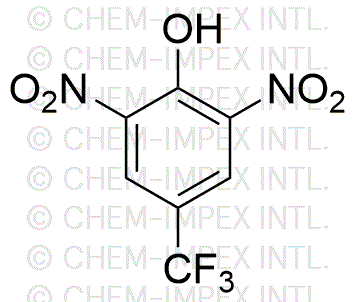2,6-Dinitro-4-(trifluoromethyl)phenol is widely utilized in research focused on:
- Agricultural Chemicals: This compound serves as an active ingredient in herbicides, helping to control unwanted vegetation effectively. Its unique chemical structure allows for targeted action against specific plant species, minimizing damage to crops.
- Analytical Chemistry: It is used as a reagent in various analytical methods, including spectrophotometry. Researchers benefit from its ability to form stable complexes, enhancing the detection of specific compounds in complex mixtures.
- Material Science: The compound is explored in the development of advanced materials, particularly in coatings and polymers. Its properties contribute to improved durability and resistance to environmental factors.
- Pharmaceutical Research: In medicinal chemistry, it is investigated for its potential as a lead compound in drug development, particularly for anti-inflammatory and antimicrobial agents, due to its biological activity.
- Environmental Studies: Researchers utilize this chemical to study its degradation pathways and environmental impact, aiding in the development of safer alternatives and better regulatory practices.
General Information
Properties
Safety and Regulations
Applications
2,6-Dinitro-4-(trifluoromethyl)phenol is widely utilized in research focused on:
- Agricultural Chemicals: This compound serves as an active ingredient in herbicides, helping to control unwanted vegetation effectively. Its unique chemical structure allows for targeted action against specific plant species, minimizing damage to crops.
- Analytical Chemistry: It is used as a reagent in various analytical methods, including spectrophotometry. Researchers benefit from its ability to form stable complexes, enhancing the detection of specific compounds in complex mixtures.
- Material Science: The compound is explored in the development of advanced materials, particularly in coatings and polymers. Its properties contribute to improved durability and resistance to environmental factors.
- Pharmaceutical Research: In medicinal chemistry, it is investigated for its potential as a lead compound in drug development, particularly for anti-inflammatory and antimicrobial agents, due to its biological activity.
- Environmental Studies: Researchers utilize this chemical to study its degradation pathways and environmental impact, aiding in the development of safer alternatives and better regulatory practices.
Documents
Safety Data Sheets (SDS)
The SDS provides comprehensive safety information on handling, storage, and disposal of the product.
Product Specification (PS)
The PS provides a comprehensive breakdown of the product’s properties, including chemical composition, physical state, purity, and storage requirements. It also details acceptable quality ranges and the product's intended applications.
Certificates of Analysis (COA)
Search for Certificates of Analysis (COA) by entering the products Lot Number. Lot and Batch Numbers can be found on a product’s label following the words ‘Lot’ or ‘Batch’.
Número de catálogo
Número de lote/lote
Certificates Of Origin (COO)
This COO confirms the country where the product was manufactured, and also details the materials and components used in it and whether it is derived from natural, synthetic, or other specific sources. This certificate may be required for customs, trade, and regulatory compliance.
Número de catálogo
Número de lote/lote
Safety Data Sheets (SDS)
The SDS provides comprehensive safety information on handling, storage, and disposal of the product.
DownloadProduct Specification (PS)
The PS provides a comprehensive breakdown of the product’s properties, including chemical composition, physical state, purity, and storage requirements. It also details acceptable quality ranges and the product's intended applications.
DownloadCertificates of Analysis (COA)
Search for Certificates of Analysis (COA) by entering the products Lot Number. Lot and Batch Numbers can be found on a product’s label following the words ‘Lot’ or ‘Batch’.
Número de catálogo
Número de lote/lote
Certificates Of Origin (COO)
This COO confirms the country where the product was manufactured, and also details the materials and components used in it and whether it is derived from natural, synthetic, or other specific sources. This certificate may be required for customs, trade, and regulatory compliance.


